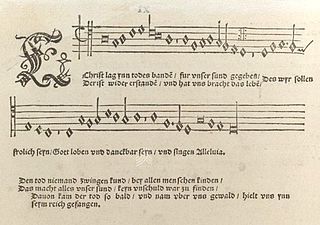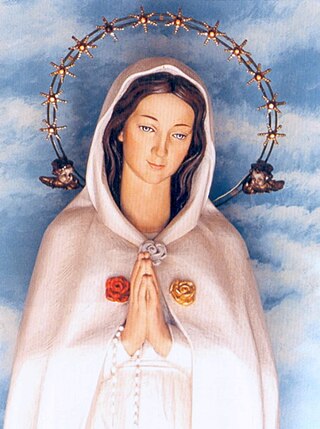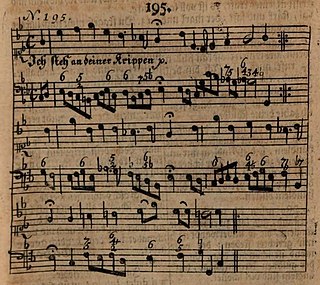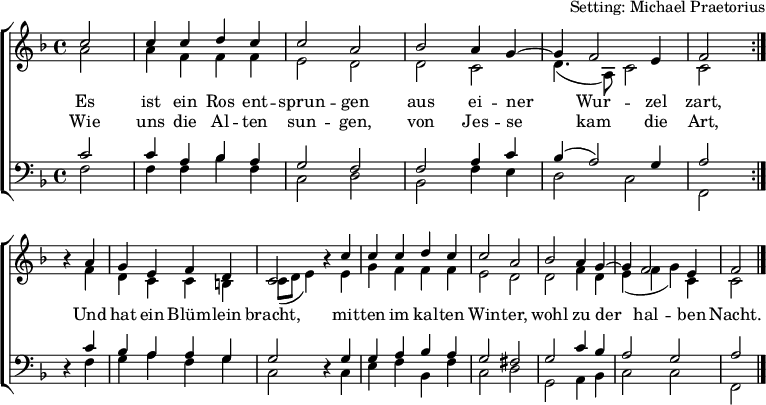
Michael Praetorius was a German composer, organist, and music theorist. He was one of the most versatile composers of his age, being particularly significant in the development of musical forms based on Protestant hymns.

Catherine Winkworth was an English hymnwriter and educator. She translated the German chorale tradition of church hymns for English speakers, for which she is recognized in the calendar of the Evangelical Lutheran Church in America. She also worked for wider educational opportunities for girls, and translated biographies of two founders of religious sisterhoods. When 16, Winkworth appears to have coined a once well-known political pun, peccavi, "I have Sindh", relating to the British occupation of Sindh in colonial India.

The Tree of Jesse is a depiction in art of the ancestors of Jesus Christ, shown in a branching tree which rises from Jesse of Bethlehem, the father of King David. It is the original use of the family tree as a schematic representation of a genealogy.

Songs for Christmas is a box set of five separate EPs of Christmas-related songs and carols recorded by independent musician Sufjan Stevens between 2001 and 2006. The EPs had been given as gifts to friends and family of Stevens over the past six years, except for 2004 when he was too busy recording the Illinois album. Though the first three EPs had already been available on Sufjan Stevens-related fansites for several years, Songs for Christmas is the first official release of these EPs. Most of the tracks are versions of traditional Christmas songs, with a number of original compositions such as "Sister Winter" and "Star of Wonder". Sufjan Stevens has developed a reputation for being a devoted Christian and many of the songs he chose for inclusion on Songs for Christmas are religious in nature, including his original compositions.

"In dulci jubilo" is a traditional Christmas carol. In its original setting, the carol is a macaronic text of German and Latin dating from the Middle Ages. Subsequent translations into English, such as J. M. Neale's arrangement "Good Christian Men, Rejoice" have increased its popularity, and Robert Pearsall's 1837 macaronic translation is a mainstay of the Christmas Nine Lessons and Carols repertoire. J. S. Bach's chorale prelude based on the tune is also a traditional postlude for Christmas services.
Jan Sandström is a Swedish classical music composer. His compositions include the so-called Motorbike Concerto for trombone and orchestra and his choral setting of Es ist ein Ros entsprungen.

A Carnegie Hall Christmas Concert is an 89-minute television film starring the opera singers Kathleen Battle and Frederica von Stade, the jazz trumpeter Wynton Marsalis, the Wynton Marsalis Septet, the American Boychoir, the Christmas Concert Chorus, the Orchestra of St. Luke's and the pianist and conductor André Previn. It first aired as part of PBS's Great Performances series in 1991, and was subsequently released on VHS, Laserdisc, DVD and CD. It was jointly produced by CAMI Video, Sony, PBS and WNET.

"Christ lag in Todesbanden" is an Easter hymn by Martin Luther. Its melody is by Luther and Johann Walter. Both the text and the melody were based on earlier examples. It was published in 1524 in the Erfurt Enchiridion and in Walter's choral hymnal Eyn geystlich Gesangk Buchleyn. Various composers, including Pachelbel, Bach and Telemann, have used the hymn in their compositions.
Es ist ein Ros entsprungen is the setting of the Christmas carol Es ist ein Ros entsprungen for two choirs a cappella by Swedish composer Jan Sandström. The work of 1990, which incorporates the harmonization by Praetorius, is one of his signature compositions, along with his Trombone Concerto No. 1, the Motorbike Concerto.
"Vater unser im Himmelreich" is a Lutheran hymn in German by Martin Luther. He wrote the paraphrase of the Lord's Prayer in 1538, corresponding to his explanation of the prayer in his Kleiner Katechismus. He dedicated one stanza to each of the seven petitions and framed it with an opening and a closing stanza, each stanza in six lines. Luther revised the text several times, as extant manuscript show, concerned to clarify and improve it. He chose and possibly adapted an older anonymous melody, which was possibly associated with secular text, after he had first selected a different one. Other hymn versions of the Lord's Prayer from the 16th and 20th-century have adopted the same tune, known as "Vater unser" and "Old 112th".
"Jesus Christus, unser Heiland, der von uns den Gotteszorn wandt" is a Lutheran hymn in ten stanzas by Martin Luther for communion, first published in 1524 in the Erfurt Enchiridion. It is one of Luther's hymns which he wrote to strengthen his concepts of reformation. The models for the text and the melody of Luther's hymn existed in early 15th-century Bohemia. The text of the earlier hymn, "Jesus Christus nostra salus", goes back to the late 14th century. That hymn was embedded in a Hussite tradition.
Requiem is a composition for solo baritone, children's choir, chorus, and orchestra by the American composer Christopher Rouse. The piece was commissioned by Soli Deo Gloria for the 2003 bicentennial of the birth of French composer Hector Berlioz. It was completed July 12, 2002 and premiered March 25, 2007 at the Walt Disney Concert Hall in Los Angeles, with the conductor Grant Gershon leading the Los Angeles Master Chorale and their orchestra, the Los Angeles Children's Chorus, and the baritone Sanford Sylvan.

Rosa Mystica is a poetic title of Mary. One form of Marian devotion is invoking Virgin Mary's prayers by calling upon her using a litany of diverse titles, and the title 'Mystical Rose' is found in the Litany of Loreto. It is also a Catholic title of Our Lady based on the Marian apparitions reported between 1947 and 1966 by Pierina Gilli at Montichiari and Fontanelle, in Italy.
Advent songs are songs and hymns intended for Advent, the four weeks of preparation for Christmas. Topics of the time of expectation are the hope for a Messiah, prophecies, and the symbolism of light, among others. Several of the songs are part of hymnals such as the German Catholic Gotteslob (GL) and the Protestant Evangelisches Gesangbuch (EG).

Kirchenlied is a German Catholic hymnal published in 1938. It was a collection of 140 old and new songs, including hymns by Protestant authors. It was the seed for a common Catholic hymnal which was realised decades later, in the Gotteslob (1975).
"Der Morgenstern ist aufgedrungen" is an Advent song and Christmas carol with lyrics by Lutheran minister Daniel Rumpius, published first in 1587. The common melody by Michael Praetorius appeared later in 1609. It was reprinted, slightly revised by Otto Riethmüller in 1932, and is part of the current Protestant hymnal Evangelisches Gesangbuch and other song books.
"Wie soll ich dich empfangen" is a Christian hymn for Advent by Paul Gerhardt. It was first published in 1653 in the fifth edition of the hymnal Praxis Pietatis Melica by Johann Crüger, who also created a melody. Johann Sebastian Bach used it as a chorale in his Christmas Oratorio, but with a different melody. Catherine Winkworth translated five of its ten stanzas.

"Ich steh an deiner Krippen hier" is a German Christmas hymn, with lyrics by Paul Gerhardt which were first published in 1653. It was then sung with an older melody by Martin Luther, but a melody which was likely created by Johann Sebastian Bach for Schemellis Gesangbuch of 1736 is now part of current Protestant and Catholic hymnals.
Die Weihnachtsgeschichte, Op. 10, is an oratorio by Hugo Distler, composed in 1933. He set Biblical texts about the nativity of Jesus in German, interspersed with different settings of stanzas of the hymn "Es ist ein Ros entsprungen", for soloists and choir a cappella. A critical edition was published by Carus-Verlag in 2015.

En natus est Emanuel is a sacred motet for Christmas by Michael Praetorius who set Latin text to music for four voices. It is part of his 1609 collection Musae Zioniae. Some write the title Enatus est Emanuel.













